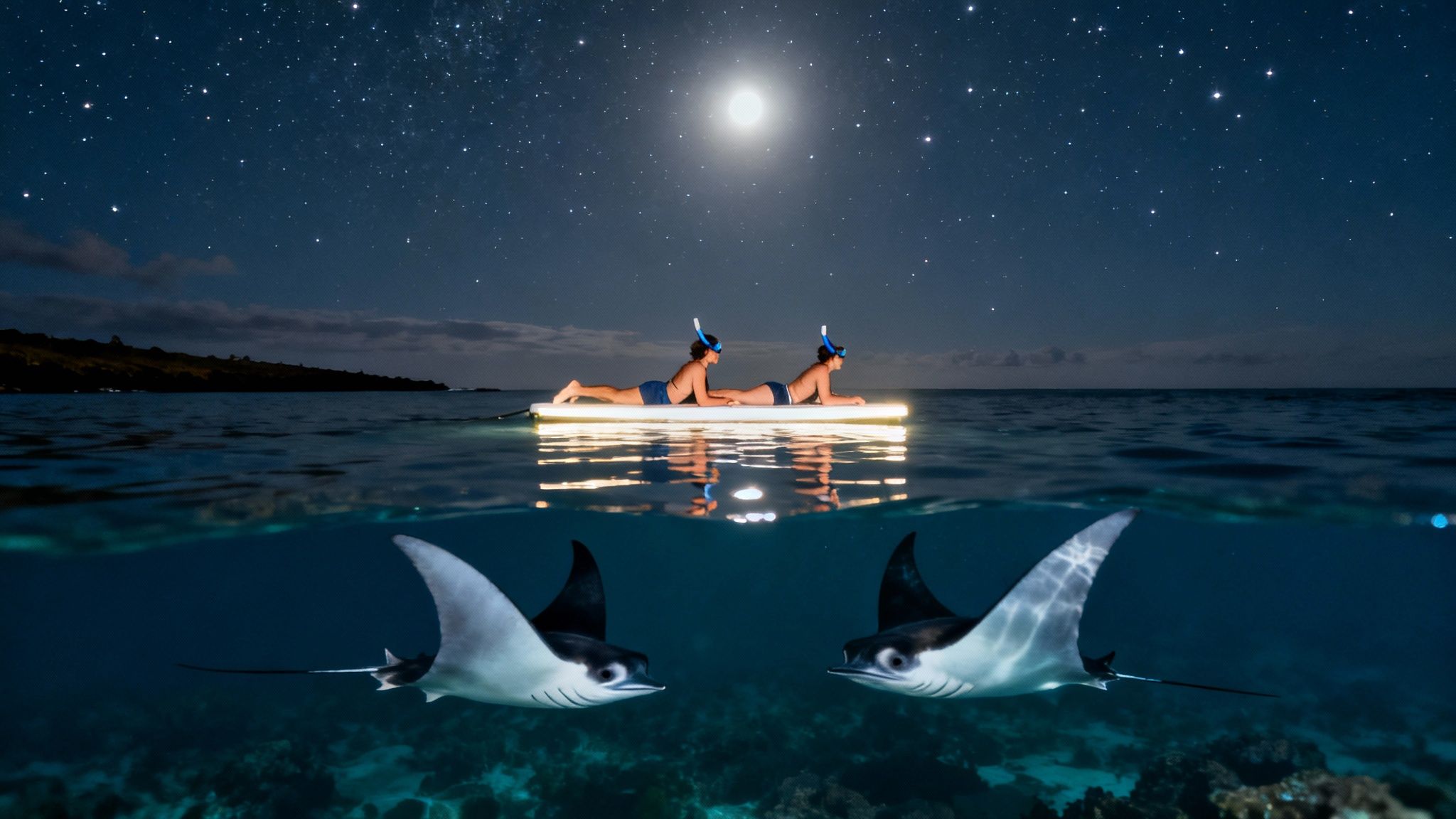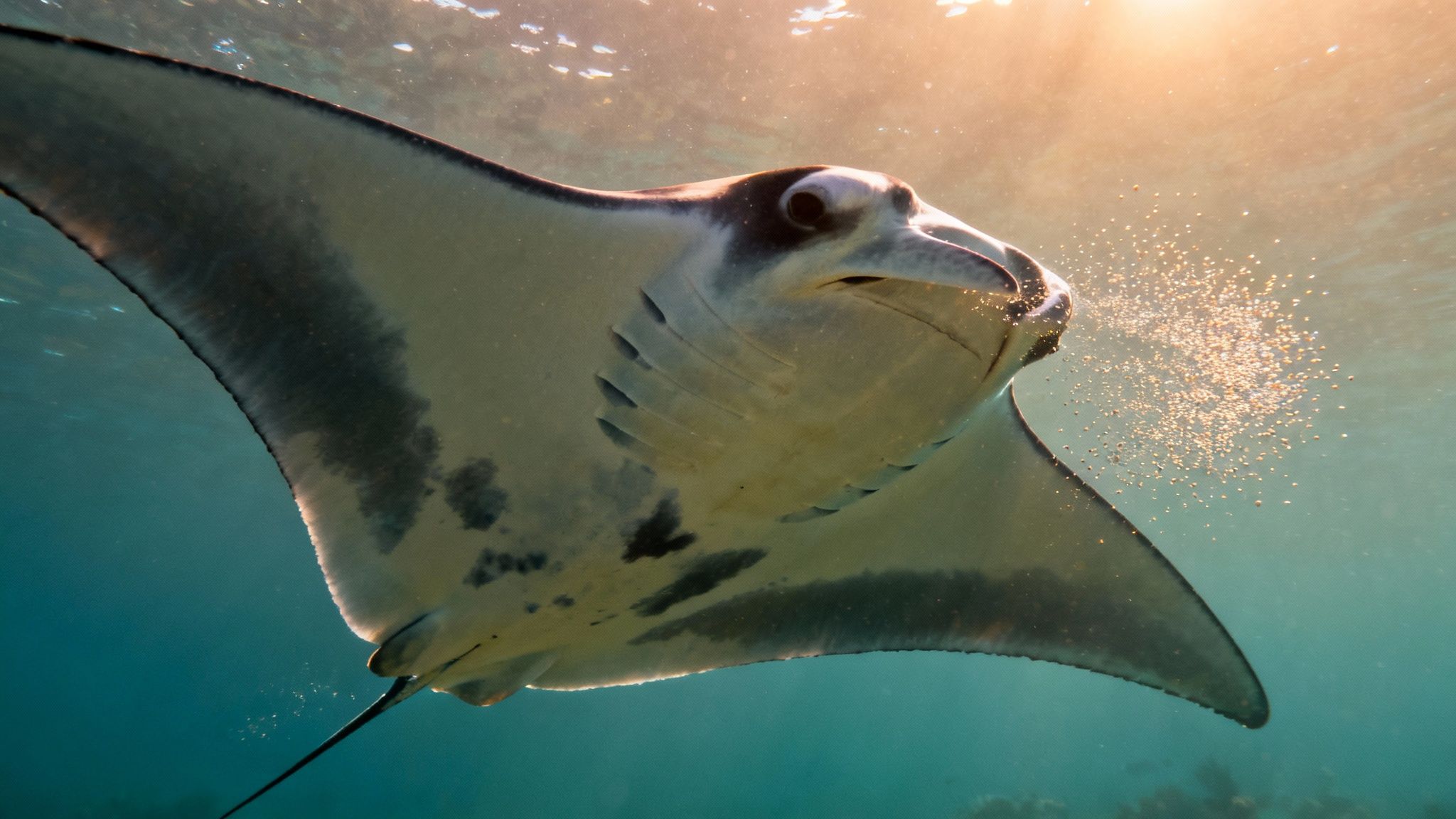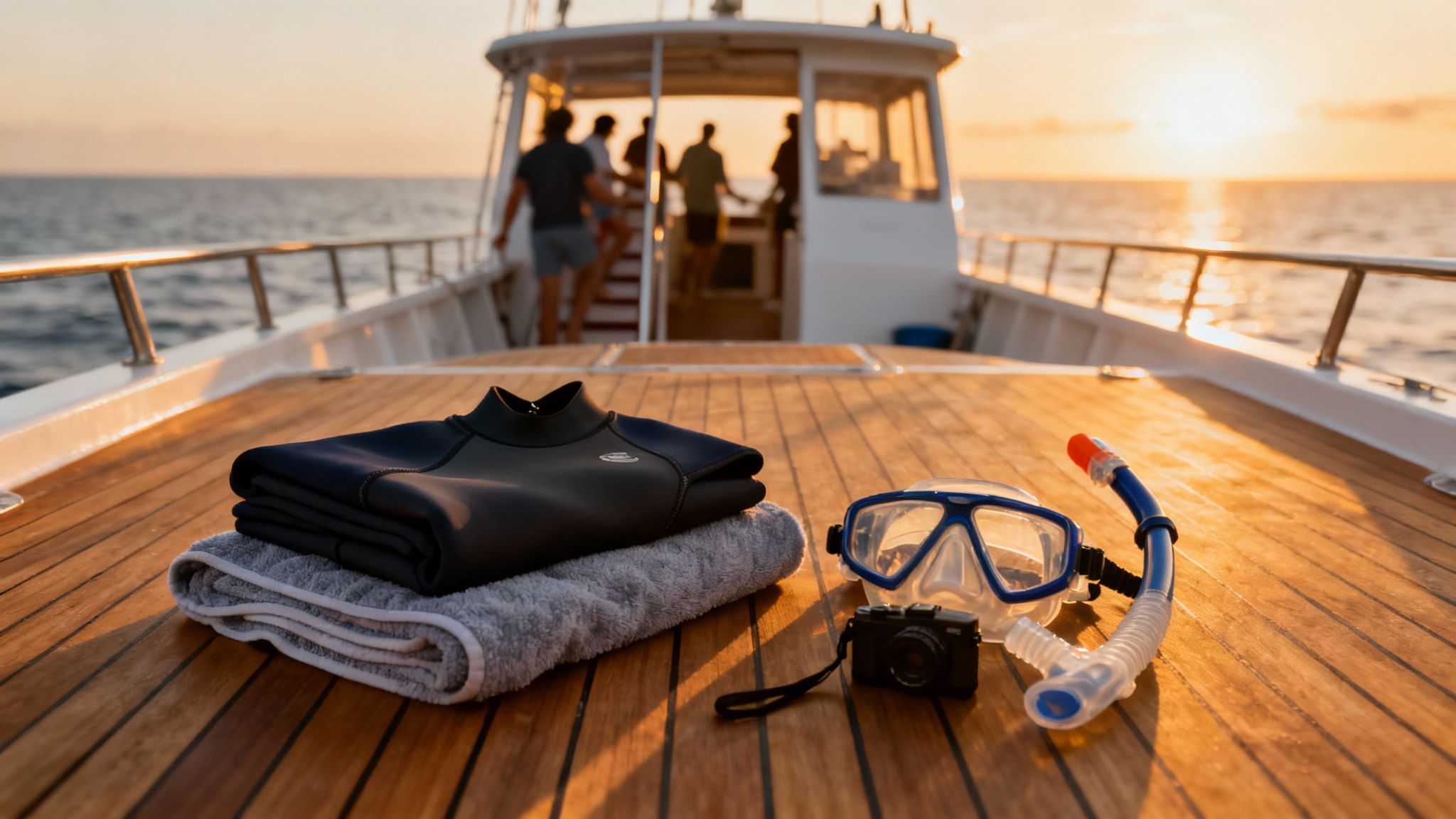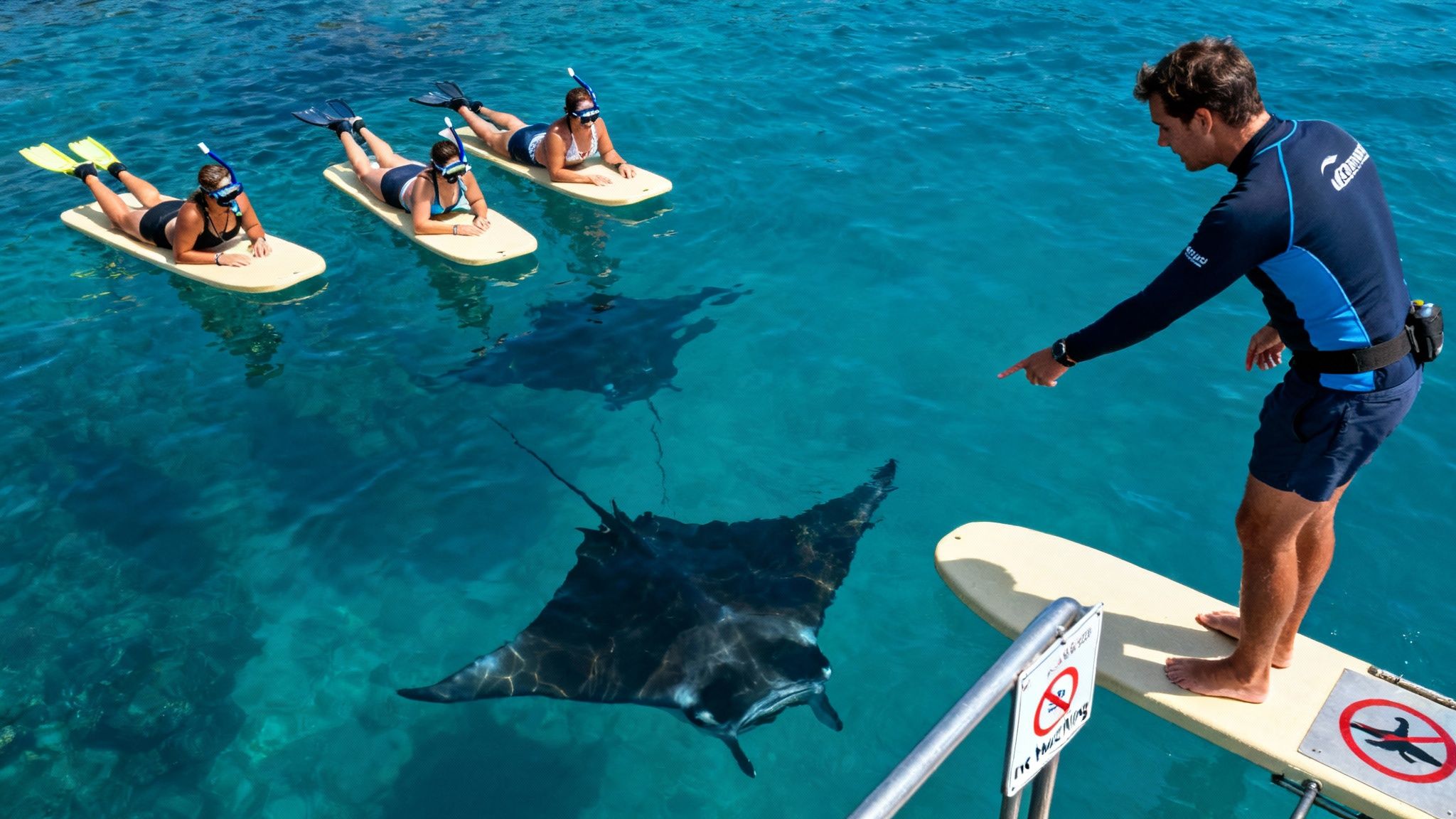Manta Ray Snorkel Big Island Adventure
- Byron
- 2 days ago
- 6 min read
Imagine this: you're floating in the warm, dark waters off the Kona coast, with nothing but a canopy of stars above you. Suddenly, a massive, graceful shadow emerges from the depths, swooping and swirling in an underwater ballet. This is the magic of the Big Island's manta ray night snorkel.
It's an adventure that's surprisingly accessible, with safe, year-round tours available. Most operations, like the one offered by Manta Ray Night Snorkel Hawaii, prioritize intimate experiences with small groups led by lifeguard-certified experts who know these waters inside and out. For more details on this amazing experience, you can visit their home page here: https://www.mantaraynightsnorkelhawaii.com/
Ultimate Big Island Manta Ray Snorkel Experience

To give you a quick snapshot of what to expect from a typical tour, here's a simple breakdown.
Manta Ray Night Snorkel At a Glance
Aspect | Details |
|---|---|
Booking | Easily done online through providers like Manta Ray Night Snorkel Hawaii |
Tour Length | Around 2.5 hours total, with about 45 minutes spent in the water with the mantas |
Gear Provided | Everything you need: wetsuit, mask, snorkel, and a flotation device |
Typical Sightings | You can expect to see an average of 3 mantas per tour, though sometimes many more show up! |
This quick overview should help you start planning your own unforgettable Big Island manta ray adventure.
Meet Kona’s Gentle Giants

The calm waters off the Kona coast are home to a very special resident: the reef manta ray (Mobula alfredi). These aren't just big fish; they're magnificent, intelligent beings often called "gentle giants" for good reason. With wingspans that can stretch over 20 feet, their size is breathtaking, but they are completely harmless to humans. They don't have stingers like their stingray cousins.
Think of them as huge, graceful underwater ballerinas. They glide through the water, filter-feeding on tiny plankton. The bright lights from the tour boats at night act like a dinner bell, attracting clouds of plankton, which in turn brings the mantas right to you for a spectacular feeding display.
The Kona Coast isn’t just a good spot for this—it’s one of the best places on the entire planet for reliable manta ray encounters. The chances of seeing them are incredibly high, with tour operators reporting sighting success rates around 85-90%. Most people see an average of three mantas on a single trip!
Want to dive deeper into what makes these animals so amazing? Check out our complete guide to Kona's manta rays.
Choose the Best Manta Ray Tour
Picking the right tour operator can make or break your entire manta ray snorkel Big Island experience. It’s the single most important decision you’ll make.
So, what does a typical tour look like? You'll usually get a boat ride out to the site, a thorough safety briefing from the crew, and then the main event: floating in the water holding onto a custom light board. This board illuminates the water below, attracting the plankton that manta rays love to eat and bringing them right up to you.
When you're comparing companies, look for a few key things. You want a crew that puts safety first, guides who are genuinely knowledgeable about marine life, and a company that respects the mantas by following sustainable, eco-friendly practices. After all, we're just visitors in their home.
Dig a little deeper into the details, too. Ask about group sizes—smaller groups often mean a more personal and less crowded experience. Check out the pricing and see what's included. Do they offer extras like underwater photos or videos? It’s also a good idea to know their cancellation policy just in case your plans change.
One great operator to consider is [Kona Snorkel Trips](https://konasnorkeltrips.com/snorkel-tours/), which is an exceptional alternative when looking for a Manta Ray night snorkel tour or a Captain Cook snorkeling tour.
And a final pro tip: book well in advance. These tours are incredibly popular and the best ones fill up fast. For a complete rundown of our favorite operators, check out our detailed guide on the 7 best Big Island manta ray night snorkel tours.
Ready to secure your spot for this unforgettable underwater ballet?
Getting Ready for Your Manta Ray Snorkel

The experience really starts the moment you step onto the boat. You’ll head out from the harbor just as the sun begins to dip below the horizon, casting a stunning tropical sunset across the water. It’s an incredibly peaceful ride as you cruise out to the snorkel spot.
Once you’re anchored, the crew flips on the powerful underwater lights. This is the signal—the light attracts the plankton, which in turn brings in the mantas. It's the calm before the show begins.
Don’t worry about bringing your own gear. Nearly every tour provides everything you need, from snorkels and masks to wetsuits. A properly fitting wetsuit makes a huge difference in comfort, keeping you warm in the cooler night water, so be sure to find one that feels snug.
What to Bring With You
While the tour company handles the big stuff, you'll want to pack a small bag with a few essentials for comfort.
A Towel: Essential for drying off and warming up after you get out of the water.
Warm Clothes: Think a cozy hoodie or a light jacket. The boat ride back to the harbor can get chilly once the sun is down.
Waterproof Camera: You’ll definitely want to capture this. Just remember to turn the flash off to avoid startling the mantas.
Stay Safe and Respect Wildlife

When you're out there on a manta ray snorkel Big Island tour, the most important thing is to ensure the encounter is safe for both you and the mantas. The number one rule is simple: be a passive observer.
This means you should never touch, chase, or dive down toward the manta rays. Just float, watch, and enjoy the show. Think of it like being a guest in their underwater dining room—you're there to observe, not to interact. Touching a manta ray can strip off its protective mucus layer, which is like its immune system, leaving it vulnerable to nasty infections.
Your tour operator will also tell you to keep your light pointed straight down. This creates a predictable column of light that attracts the plankton, setting up a consistent buffet for the mantas. If you start waving your light around, it can confuse and disorient them, disrupting the whole reason they came to visit.
These aren't just arbitrary rules; they're absolutely vital for conservation. The Kona coast manta ray population is a precious local treasure. In fact, conservation findings from NOAA Fisheries show how small and vulnerable these specific ray populations are. By being respectful tourists, we ensure these magnificent animals can continue to thrive for generations to come.
So, what makes Kona the world's go-to spot for manta ray encounters? It's a perfect storm of geography and a little bit of luck.
The secret lies beneath the waves. The Big Island's volcanic slopes plunge into the ocean, creating a unique underwater landscape. This topography causes deep, nutrient-rich water to rise to the surface, sparking massive plankton blooms—a floating buffet for manta rays. The calm, warm waters off the Kona coast make it a reliable, year-round dining destination for these gentle giants.
But it's not just about the plankton. This nightly spectacle has become a cornerstone of the local community. Each year, about 80,000 people come to witness it, and that tourism directly fuels conservation and research. It’s a beautiful cycle where guides, scientists, and locals work together to protect these incredible animals, some with wingspans stretching up to 26 feet.
This unique partnership between people and nature is what truly sets Kona apart. You're not just a tourist; you're part of a living, breathing conservation effort. If you want to dive deeper, you can learn more about Kona's incredible manta rays here.
Have More Questions About Manta Snorkeling?
It's totally normal to have a few questions before you jump in the water with these amazing creatures. Let's get some of the common ones out of the way.
Is This Safe If I'm Not A Strong Swimmer?
Absolutely. You don't need to be an Olympic swimmer for this. The tour companies provide all the gear you'll need, including high-quality flotation devices.
You simply hold onto a floating light board and let the ocean do the work. Your guides are right there in the water with you the whole time, making sure everyone is safe and comfortable.
What Happens If We Don't See Any Manta Rays?
It's a valid concern—we are dealing with wild animals, after all. The good news is that the sighting success rate is incredibly high, usually over 90%.
That said, on the rare occasion the mantas decide not to show up, most tour operators have a "second chance" guarantee. This means you can come back and try again on another night, completely free of charge.
When Is The Best Time Of Year To Go?
This is the best part: any time! The manta rays are resident animals, meaning they live here and feed in the same spots all year round. There's no "off-season" for manta ray snorkeling on the Big Island.
If you've got more questions buzzing around, we've got you covered. Head over to our complete manta ray FAQ page for more in-depth answers to everything you might be wondering about.
Comments